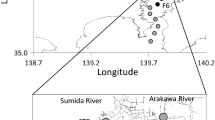Abstract
Nanming River, the largest urban river in Guizhou Province, southwestern China plateau, has been severely polluted for decades. This study characterizes the organic materials and their sources in the upstream and downstream waters by dissolved organic carbon (DOC), excitation emission matrix (EEM) spectroscopy, parallel factor (PARAFAC) analysis and photo-microbial experiments. DOC concentrations were low (47–120 μM C) upstream and relatively high (146–462 μM C) downstream. The PARAFAC studies on the sample EEM spectra demonstrated that the upstream dissolved organic matter (DOM) was mostly composed of one component that had a fulvic acid-like substance; downstream DOM was composed of two components with mixtures of tryptophan-like and fulvic acid-like substances. From the results of the sewerage drainage samples collected along the bank of the river, it is evident that both household detergent-like and protein-like or tryptophan-like substances are predominantly present, indicating that untreated sewerage effluents are the major sources of organic matter pollution in Nanming River. The degradation experiments conducted on river, sewerage drainage and commercial detergent samples demonstrated that the detergent-like and tryptophan-like substances are both photochemically and microbiologically more decomposable than fulvic acid-like materials under sunlight and dark incubations. These results suggest that the input of the untreated sewerage effluents along the streams is the major pollution source in Nanming River, and the fluorescent DOM was efficiently affected by both photochemical and microbial processes.






Similar content being viewed by others
References
Aiken GR, McKnight D, Weshaw RL, MacCarthy P (1985) An introduction to humic substances in soil sediment and water. In: Aiken GR, McKnight D, Wershaw RL, MacCarthy P (eds) Humic substances in soil sediment and water. Wiley, New York
Baker A (2001) Fluorescence excitation-emission matrix characterization of some sewage impacted rivers. Environ Sci Technol 35:948–953
Baker A (2002a) Fluorescence excitation-emission matrix characterization of some farm wastes: Implications for water quality monitoring. Water Res 36:189–194
Baker A (2002b) Fluorescence excitation–emission matrix characterization of river waters impacted by tissue mill effluents. Environ Sci Technol 36:1377–1382
Baker A (2005) Thermal fluorescence quenching properties of dissolved organic matter. Water Res 39:4405–4412
Baker A, Curry M (2004) Fluorescence of leachates from three contrasting landfills. Water Res 38:2605–2613
Baker A, Inverarity R (2004) Protein-like fluorescence intensity as a possible tool for determining river water quality. Hydrol Process 18:2927–2945
Borisover M, Laor Y, Parparov A, Bukhanovsky N, Lado M (2009) Spatial and seasonal patterns of fluorescent organic matter in Lake Kinneret (Sea of Galilee) and its catchment basin. Water Res 43:3104–3116
Bro R (1997) PARAFAC Tutorial and applications. Chemom Intell Lab Syst 38:149–171
Bro R (1999) Exploratory study of sugar production using fluorescence spectroscopy and multi-way analysis. Chemom Intell Lab Syst 46:133–147
Chau KW (2006) Persistent organic pollution characterization of sediments in Pearl River estuary. Chemosphere 64:1545–1549
Coble PG (1996) Characterization of marine and terrestrial DOM in sea water using excitation-emission matrix spectroscopy. Mar Chem 52:325–336
Coble PG (2007) Marine optical biogeochemistry: the chemistry of ocean color. Chem Rev 107:402–418
Coble PG, Green SA, Blough NV, Gagosian RB (1990) Characterization of dissolved organic matter in the Black Sea by fluorescence spectroscopy. Nature 348:432–435
Cory RM, McKnight DM (2005) Fluorescence spectroscopy reveals ubiquitous presence of oxidized and reduced quinines in dissolved organic matter. Environ Sci Technol 39:8142–8149
Fu PQ, Wu FC, Liu CQ, Wang F, Li W, Yue L, Guo QJ (2007) Fluorescence characterization of dissolved organic matter in an urban river and its complexation with Hg(II). Appl Geochem 22:1668–1679
Hall GJ, Clow KE, Kenny JE (2005) Estuarial fingerprinting thorough multidimensional fluorescence and multivariate analysis. Environ Sci Technol 39:7560–7567
Hayakawa K, Okumura R, Yamamoto H, Fujiwara M, Yamaji N, Takada H, Kanematsu M, Shimizu Y (2007) Distribution and fluxes of fluorescent whitening agents discharged from domestic wastewater into small rivers with seasonal changes of flow rates. Limnology 8:251–259
Hayashi Y, Managaki S, Takada H (2002) Fluorescent whitening agents in Tokyo Bay and adjacent rivers their application as anthropogenic molecular markers in coastal environments. Environ Sci Technol 36:3556–3563
Hudson N, Baker A, Renolds D (2007) Fluorescence analysis of dissolved organic matter in natural waste and polluted waters—a review. River Res Appl 23:631–649
Komaki M, Yabe A (1982) Fluorometric analysis of fluorescent brightening agents in natural waters. Chem Soc J 5:859–867 (in Japanese)
Kramer JB, Canonica S, Hoigne J, Kaschig J (1996) Degradation of fluorescent whitening agents in sunlit natural waters. Environ Sci Technol 30:2227–2234
Luo X-J, Chen S-J, Mai B-X, Sheng G-Y, Fu J-M, Zeng EY (2008) Distribution source apportionment and transport of PAHs in sediments from the Pearl River delta and the northern south China sea. Arch Environ Contam Toxicol 55:11–20
Malcolm RL (1985) Geochemistry of stream fulvic and humic substances. In: Aike GR, McKnight DM, Wershaw RL, MacCarthy P (eds) Humic substances in soil, sediment, and water: geochemistry, isolation and characterization. Wiley, New York, pp 181–209
Managaki S, Takada H (2005) Fluorescent whitening agents in Tokyo Bay sediments, molecular evidence of lateral transport of land-derived particulate matter. Mar Chem 95:113–127
Moran MA Jr, Sheldon WM, Zepp RG (2000) Carbon loss and optical property changes during long-term photochemical and biological degradation of estuarine dissolved organic matter. Limnol Oceanogr 45:1254–1264
Mostofa KMG, Honda Y, Sakugawa H (2005a) Dynamics and optical nature of fluorescent dissolved organic matter in river waters in Hiroshima prefecture, Japan. Geochem J 39:257–271
Mostofa KMG, Yoshioka T, Konohira E, Tanoue E, Hayakawa K, Takahashi M (2005b) Three-dimensional fluorescence as a tool for investigating the dynamics of dissolved organic matter in the Lake Biwa watershed. Limnology 6:101–115
Mostofa KMG, Yoshioka T, Konohira E, Tanoue E (2007a) Dynamics and characteristics of fluorescent dissolved organic matter in the groundwater, river and lake water. Water Air Soil Pollut 184:157–176
Mostofa KMG, Yoshioka T, Konohira E, Tanoue E (2007b) Photodegradation of fluorescent dissolved organic matters in river waters. Geochem J 41:323–331
Mostofa KMG, Wu FC, Yoshioka T, Sakugawa H, Tanoue E (2009) Dissolved organic matter in the aquatic environments In: Wu FC, Xing B (eds) Natural organic matter and its significance in the environment. Science Press, Beijing, pp 3–66
Parlanti E, Worz K, Geoffroy L, Lamotte M (2000) Dissolved organic matter fluorescence spectroscopy as a tool to estimate biological activity in a coastal zone submitted to anthropogenic inputs. Org Geochem 31:1765–1781
Poiger T, Field FJA, Field TM, Giger W (1996) Occurrence of fluorescent whitening agents in sewage and river water determined by solid-phase extraction and high-performance liquid chromatography. Environ Sci Technol 30:2220–2226
Poiger T, Kari FG, Giger W (1999) Fate of fluorescent whitening agents in the River Glatt. Environ Sci Technol 33:533–539
Rosenstock B, Simon M (2001) Sources and sinks of dissolved free amino acids and protein in a large and deep mesotrophic lake. Limnol Oceanogr 50:90–101
Schwede-Thomas SB, Chin Y, Dria KJ, Hatcher P, Kaiser E, Sulzberger B (2005) Characterizing the properties of dissolved organic matter isolated by XAD and C-18 solid phase extraction and ultrafiltration. Aquat Sci 67:61–71
Senesi N (1990) Molecular and quantitative aspects of the chemistry of fulvic acid and its interactions with metal ions and organic chemicals Part II The fluorescence spectroscopy approach. Anal Chim Acta 232:77–106
Stedmon CA, Markager S (2005) Tracing the production and degradation of autochthonous fractions of dissolved organic matter by fluorescence analysis. Limnol Oceanogr 50:1415–1426
Stedmon CA, Markager S, Bro R (2003) Tracing dissolved organic matter in aquatic environments using a new approach to fluorescence spectroscopy. Mar Chem 82:239–254
Stedmon CA, Thomas DN, Granskog M, Kaartokallio H, Papaditriou S, Kuosa H (2007) Characteristics of dissolved organic matter in Baltic coastal sea ice: allochthonous or autochthonous origins? Environ Sci Technol 41:7273–7279
Stoll J-MA, Giger W (1998) Mass balance for detergent-derived fluorescent whitening agents in surface waters of Switzerland. Water Res 32:2041–4050
Stoll J-MA, Ulrich MM, Giger W (1998) Dynamic behavior of fluorescent whitening agents in Greifensee: field measurements combined with mathematical modeling of sedimentation and photolysis. Environ Sci Technol 32:1875–1881
Sugiyama Y, Anegawa A, Inokuchi H, Kumagai T (2005) Distribution of dissolved organic carbon and dissolved fulvic acid in mesotrophic Lake Biwa, Japan. Limnology 6:161–168
Takada H, Ogura N, Ishiwatarl R (1992) Seasonal variations and modes of riverine input of organic pollutants to the costal zone: 1. Flux of detergent-derived pollutants to Tokyo bay. Environ Sci Technol 26:2517–2523
Takahashi M, Kawamura K (2007) Simple simple measurement of 4, 4′-bis(2-sulfostyryl)-biphenyl in river water by fluorescence analysis and its application as an indicator of domestic wastewater contamination. Water Air Soil Pollut 180:39–49
Tanoue E (2000) Proteins in the sea-synthesis. In: Handa N, Tanoue E, Hama T (eds) Dynamics and characterization of marine organic matter. TERRAPUB/Kluwer, Tokyo, pp 383–463
Volk CJ, Volk CB, Kaplan LA (1997) Chemical composition of biodegradable dissolved organic matter in streamwater. Limnol Oceanogr 42:39–44
Wu CH, Maurer C, Wang Y, Xue SZ, Davies DL (1999) Water pollution and human health in China. Environ Health Perspect 4:251–256
Wu FC, Mills RB, Evans RD, Dillon PJ (2005) Photodegradation-induced changes in dissolved organic matter in acidic waters. Can J Fish Aquat Sci 62:1019–1027
Yamashita Y, Jaffé R (2008) Characterizing the interactions between trace metals and dissolved organic matter using excitation–emission matrix and parallel factor analysis. Environ Sci Technol 42:7374–7379
Yamashita Y, Tanoue E (2003) Chemical characterization of protein-like fluorophores in DOM in relation to aromatic amino acids. Mar Chem 82:255–271
Acknowledgments
This work was jointly funded by the National Basic Research Program of China (2008CB418200) and National Natural Science Foundation of China (1314765, U0833603, 40632011). We are grateful to the two anonymous reviewers for their valuable and thoughtful comments on the manuscript.
Author information
Authors and Affiliations
Corresponding author
Rights and permissions
About this article
Cite this article
Mostofa, K.M.G., Wu, F., Liu, CQ. et al. Characterization of Nanming River (southwestern China) sewerage-impacted pollution using an excitation-emission matrix and PARAFAC. Limnology 11, 217–231 (2010). https://doi.org/10.1007/s10201-009-0306-4
Received:
Accepted:
Published:
Issue Date:
DOI: https://doi.org/10.1007/s10201-009-0306-4




